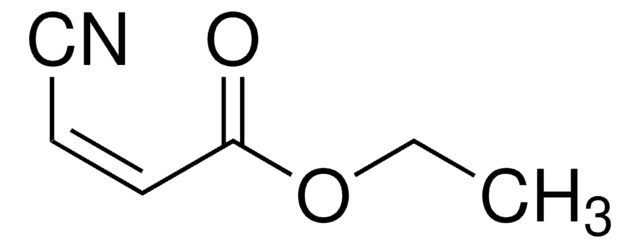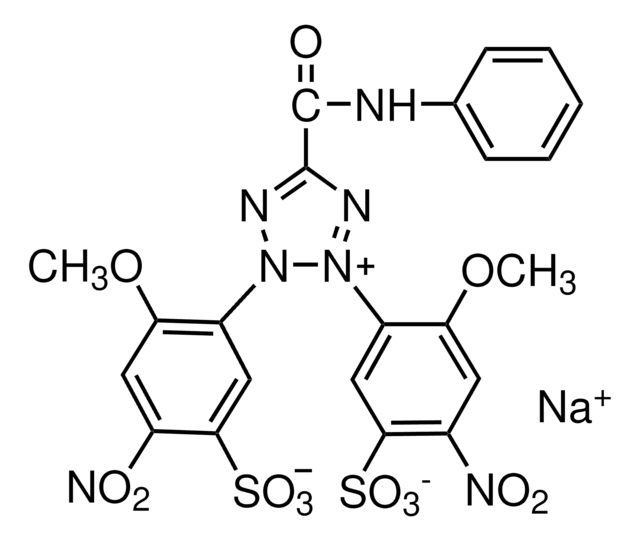E1505
Ethyl 2-cyanoacrylate
liquid
Sinónimos:
ethyl 2-cyanoprop-2-enoate
Iniciar sesiónpara Ver la Fijación de precios por contrato y de la organización
About This Item
Fórmula empírica (notación de Hill):
C6H7NO2
Número de CAS:
Peso molecular:
125.13
Número CE:
Número MDL:
Código UNSPSC:
12162002
ID de la sustancia en PubChem:
NACRES:
NA.23
Productos recomendados
formulario
liquid
Nivel de calidad
temp. de almacenamiento
2-8°C
cadena SMILES
CCOC(=O)C(=C)C#N
InChI
1S/C6H7NO2/c1-3-9-6(8)5(2)4-7/h2-3H2,1H3
Clave InChI
FGBJXOREULPLGL-UHFFFAOYSA-N
Descripción general
Ethyl 2-cyanoacrylate belongs to the class of monomers known as cyanoacrylates. Ethyl 2-cyanoacrylate polymers are primarily used as adhesives due to their fast-setting and strong bonding properties. They are widely utilized for bonding a variety of materials, including metals, plastics, rubber, ceramics, and wood. These adhesives are used in industries such as automotive, electronics, crafts, and general repairs. Ethyl 2-cyanoacrylate adhesives find applications in industrial and manufacturing processes. They are used for sealing products, encapsulating electronics, and securing parts during assembly.
Aplicación
Ethyl 2-cyanoacrylate, commonly known as super glue, has several uses in the field of bioadhesives:
- Wound Closure: Ethyl 2-cyanoacrylate is often used in medical settings to close small cuts and wounds. It forms a strong bond when it comes into contact with moisture, effectively sealing the wound.
- Tissue Adhesives: In surgical and medical applications, ethyl 2-cyanoacrylate is used to adhere tissues together. It can be used as an alternative to traditional sutures or staples in certain procedures.
- Drug Delivery Systems: In some cases, ethyl 2-cyanoacrylate has been investigated as a component in drug delivery systems and tissue engineering due to its biocompatibility and ability to form strong bonds with biological materials.
- It can also be mixed with hydrophobic silica nanoparticles for the designing of cotton fabrics for medical applications.
Palabra de señalización
Warning
Frases de peligro
Consejos de prudencia
Clasificaciones de peligro
Eye Irrit. 2 - Skin Irrit. 2 - STOT SE 3
Órganos de actuación
Respiratory system
Código de clase de almacenamiento
10 - Combustible liquids
Clase de riesgo para el agua (WGK)
WGK 1
Punto de inflamabilidad (°F)
185.0 °F - closed cup
Punto de inflamabilidad (°C)
85 °C - closed cup
Equipo de protección personal
Eyeshields, Faceshields, Gloves
Elija entre una de las versiones más recientes:
¿Ya tiene este producto?
Encuentre la documentación para los productos que ha comprado recientemente en la Biblioteca de documentos.
Asymmetric superhydrophobic/superhydrophilic cotton fabrics designed by spraying polymer and nanoparticles
Sasaki K, et al.
ACS Applied Materials & Interfaces, 8(1), 651-659 (2015)
Antonella Obinu et al.
Colloids and surfaces. B, Biointerfaces, 177, 520-528 (2019-03-02)
Tumor eradication has many challenges due to the difficulty of selectively delivering anticancer drugs to malignant cells avoiding contact with healthy tissues/organs. The improvement of antitumor efficacy and the reduction of systemic side effects can be achieved using drug loaded
Marina C Jeppsson et al.
Journal of chromatography. B, Analytical technologies in the biomedical and life sciences, 878(27), 2474-2482 (2010-05-18)
Acrylates are used in vast quantities, for instance in paints, adhesive glues, molding. They are potent contact allergens and known to cause respiratory hypersensitivity and asthma. Here we study ethyl 2-cyanoacrylate (ECA), methyl methacrylate (MMA) and 2-hydroxyethyl methacrylate (HEMA). There
Xiaofeng Li et al.
Journal of colloid and interface science, 340(1), 93-97 (2009-09-12)
Hollow microspheres of poly(ethyl alpha-cyanoacrylate) were prepared via vapor phase polymerization using micro-waterdroplets as template and initiator. Depending on the ratio of the shell thickness to the radius, the hollow microspheres would crimple to form either microballoons or microcups during
S Saska et al.
International journal of oral and maxillofacial surgery, 38(2), 180-186 (2009-01-23)
This study compared the fixation of autogenous onlay bone grafts with cyanoacrylate glue (Super Bonder) and with titanium screws. Twenty rabbits underwent bilateral parietal ostectomies. Bone segments were fixed anteriorly to the resulting bone defect. In group I, the grafts
Nuestro equipo de científicos tiene experiencia en todas las áreas de investigación: Ciencias de la vida, Ciencia de los materiales, Síntesis química, Cromatografía, Analítica y muchas otras.
Póngase en contacto con el Servicio técnico









